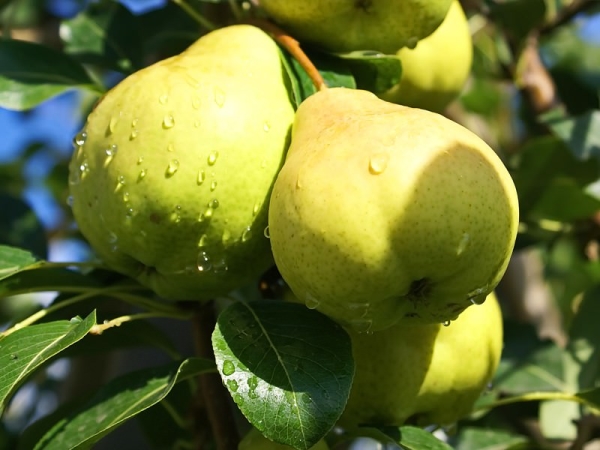In a wide variety of varieties of pears you always want to choose a sweet one, with high yields, unpretentious and easy to care for.
This is August dew, which fell in love with gardeners and farmers. The following describes the variety, advantages and disadvantages, how to choose a seedling, plant and care.
Table of contents
Characteristics and description of the variety Avgustovskaya dew
August dew - summer pear variety. Germinates in the Central Black Earth region (since 2002). Obtained by crossing the variety Tenderness and Triumph Pakgam.
Variety bred S. P. Yakovlev at the All-Russian Research Institute of Genetics and Breeding of Fruit Plants. I.V. Michurin.
The height of the tree reaches three meters. Harvest brings annually from 4 years of landing in the ground. The yield is high up to 200 kg / ha in the most fruitful age.
The first harvest is about 15 kg from a single tree. It tolerates wintersthat are characteristic of germination areas.
Disease resistant. High ability to form shoots and kidney wake.
Characteristics of the tree structure:
- light gray bark color, smooth;
- lowered crown with medium thickness;
- straight branches. The location of the fruit on the long and short kolchatkah and spears;
- light brown, wide and curved shoots. A large number of small-sized lentils;
- conical buds of medium size, slightly bent to the side;
- oblong ovate leaves with a wedge-shaped base in a dark green color. Average value. Serrations at the edges. Saber-shaped small stipules;
- petioles of medium thickness and length;
- white flowers are saucer-shaped, small. Sepals are long, directed to the pedicel. Pistils long - above the anthers. In one inflorescence 7-10 flowers.
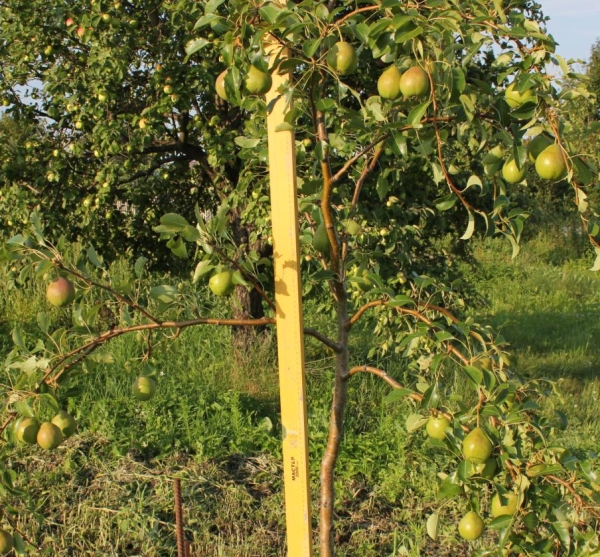
Fruit characteristics:
- the fruit is of medium size, weighing from 100 to 200 g. Pear-shaped, not ribbed;
- smooth skin with dots. Color in the period of maturity - green or greenish-yellow with a slight “blush” in a small area of the fruit;
- white and fine-grained flesh with a sour-sweet taste and delicate texture;
- the stem is curved, long and wide enough;
- the small funnel has a conical shape;
- small, closed cup;
- the saucer is small, slightly expanded, has a ribbed shape;
- the core is large, onion-shaped;
- medium sized seeds, closed;
- keep well on the tree;
- ripening period - mid-August - September;
- the period of storage and use is two weeks;
- table pear;
- the best pollinator is a variety in memory of Yakovlev.
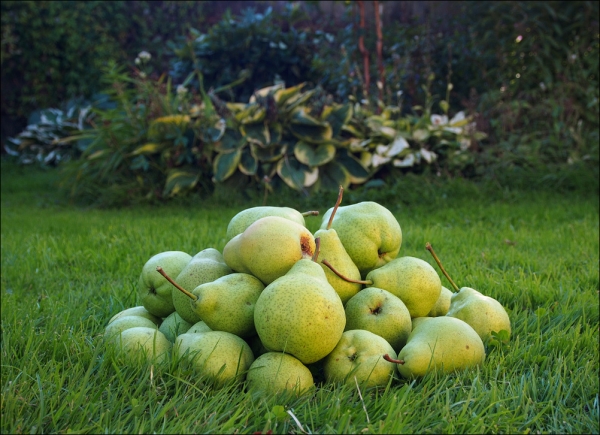
Features and advantages:
- Winter hardiness and frost resistance.
- Not picky about droughts.
- High yield.
- Skoroplodnost.
- Excellent presentation.
- A small percentage of cases of tree damage by diseases or pests.
- Fruits are easily processed into jam, jam and dried fruits. Good taste.
disadvantages: at large yields, heterogeneity of fruits occurs.
The benefits and harm of pears
The benefits of pears. August dew is great. It is useful for adults, children - does not cause allergies, discomfort in the intestine and a beneficial effect on the body.
Actively used in traditional medicine. when coughing, chills, inflammation of the urogenital system, stone disease. A good helper in the fight against fungus, dermatitis.
In addition, the pear contains:
- vitamin C (ascorbic acid) helps to strengthen the immune system and increase the elasticity of blood vessels;
- vitamin k - source of calcium;
- vitamin b9 active participant in the process of blood formation;
- cellulose useful for the digestive tract, because it lowers cholesterol and normalizes the intestinal microflora. Fights constipation. Improves appetite;
- sulfur helps strengthen hair and nails;
- potassium performs the protective function of the heart and helps the recovery of cells. Warns the appearance of edema;
- cobalt supports the work of the thyroid gland, kidneys. Accumulates hemoglobin and helps the rapid absorption of iron.
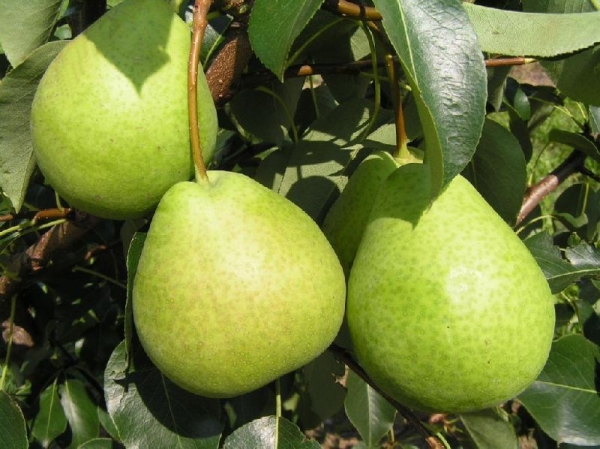
It should be noted that with a huge "set" of useful properties of pear it can still harm. This applies to the use of fruit with gastritis, colitis and ulcers.
The danger is unripe, hard fruit for children and people in age.
How to choose a seedling?
The choice of seedlings - the key to high yield. To pick the “right” sapling, must adhere to such rules:
- Variety Avgustovskaya dew take root and will yield only in an area with favorable climatic conditions (central and southern regions with black soil).
- Buy seedlings only in special nurseries to avoid cheating and buying another variety.or wood.
- It is worth paying attention to the roots of the sapling - fresh, not dry, not frozen. The longer (from 30 cm) and more branched root system, the greater the likelihood of a good survival of the seedling.
- If you cut the root, it should be white. The change in color indicates that the seedling is frozen or dried.
- Carefully examine the root. The presence of blistering indicates a disease (root cancer).
- The barrel is flat, not damaged.
- Seedling about a year or two.
Preparation for disembarkation
In addition to choosing a seedling, it is necessary to prepare the soil well to his landing - a pledge of survival.
Pre-fertilizer for the future planting site (type, amount of fertilizer depends on the soil). Pear Avgustovskaya dew has a small crown, so the distance between seedlings permissible 5 m.
Planting seedlings
Planted seedlings need autumn (early October) or spring (late April). Regardless of the season, the landing technology is the same:
- Prepare a pit.The pit is 1 m in diameter and 0.5 m deep. Roots should be placed freely in it.
- Fill in fertilizers (humus, saltpeter, potassium).
- Spread the roots.
- Holding the seedling in a hole, cover it with soil so that the root collar disappears under the ground, tamp and pour.
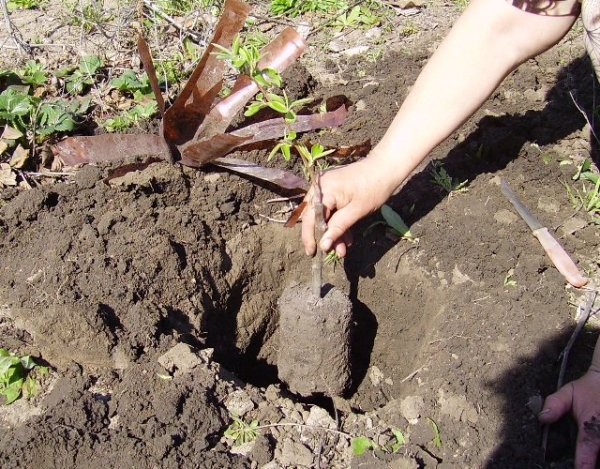
Rules for tree and fruit care
After the correct selection of seedlings, soil preparation and planting a young tree directly, care is important.
Tillage. Before watering, as necessary, destroy the weeds and loosen the soil.
Watering. About 5 times (summer) per month (1 bucket - 1 tree). Watering should be slow, so that all the water is absorbed into the hole of the pear and “watered” the roots. In a drought, it is better to water in the early morning and evening for half a bucket at a time.
By autumn, reduce watering and then stop. Spring watering begin gradually. The volume of water is adjusted by rainfall and season.
Trimming. Every spring to remove extra vertical shoots at a level of 0.5 m from the ground. Pruning in the fall can lead to the death of the tree - cuts may not have time to drag on to the first frost. This does not apply to damaged and dry branches.
You should not neglect cutting trees, because the size and sugar content of fruits depend on it.

Top dressing. The August dew loves organic fertilizers - manure that contains all the substances needed by the tree. It is necessary to bring in no more than 2 kg of manure per 1 m2 of the tree edge.
Top dressing is better to do in spring (March-April), annually. In the fall, after leaf fall, you must apply nitrogen fertilizer or the same manure.
Preparing for the winter. In late autumn, the tree is treated with limestone solution. This will protect the bark from sunburn and pests loving the bark.
Harvesting falls in August-September, depending on weather conditions. The older the tree, the greater the yield.
Store pears no more than two weeks in a cool place and about three months in a cellar (in wooden boxes) or a refrigerator.
Diseases and pests. Methods of struggle
Despite the fact that the August dew is a fairly resistant variety to pests, it is necessary to carry out prevention every spring. For this, both chemical agents (fungicides, insecticides) and folk (herbal extracts) are suitable.
When wounds and cracks appear on the root with brown spots (black cancer) it is necessary to remove the affected leaves and bark, capturing 2 cm of healthy areas. Process copper sulphate.
Noticing the powdery spots on the leaves and flowers it is necessary to remove the affected areas and treat with Topaz. When watering use colloidal sulfur.
Fruit rot will remove and warns the appearance of the drug with Oxy and a solution of borodian fluid 1%. Handle after flowering.
When insect pests will help solution of Nitrafen, Kinmiks, Spark, etc.
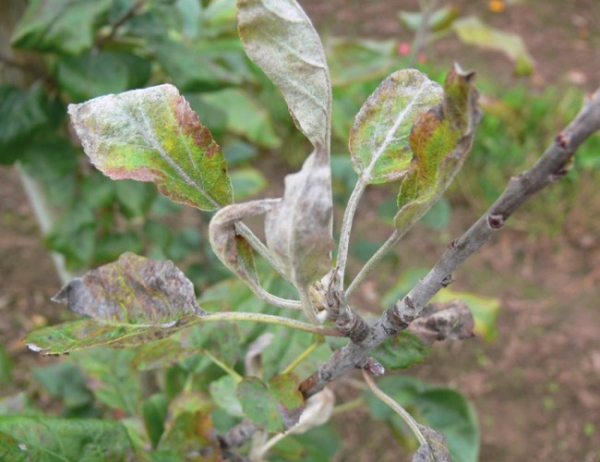
Gardeners reviews
“At last this year the tree bore the first fruits, the first two pears. Avgustovskaya dew by reviews cool class, but ...! These two pears are big, beautiful, but the taste is ... green! Not mature, but in the yard in a week in October and frost. Slavka. "
“Pear Avgustovskaya dew is not quite a capricious variety of fruit tree.Thanks to its high yielding, skoroplodnosti and compactness of the tree, it can quickly gain respect. Compliance with the basic conditions of care will bring a rich harvest of delicious fruits. A pear takes root more easily than an apple tree. Very juicy. And the keeping quality is short for all of them almost ... Filipina. "
“I grew up A. Rosa from a graft graft, there was such a purchase on the forum in the old years. Sumakhi, loch narrow-leaved, Shepherdia, Robinia, near growing - they all froze to the ground, and she somehow reached fetus and did not sneeze. Filiponka. "
“I once only wanted to plant the August dew, it was grown in our nursery. But then I talked to its director, he said that they had abandoned her - not winter-hardy in our conditions (east). lubov. "
“After the frosts that suddenly returned, the pear varieties were frozen out in seedlings that allegedly have a high degree of winter hardiness: August dew, Gracia, Zimnyaya, Glazkova, Martian, Tenderness and Chizhevskaya. Aleksandr Kuznetsov."
With a large variety of pear varieties justified trust earned Augustus dew grade. And not for nothing, because he has a lot of advantages.
It is resistant to frost, pests, unpretentious care, marketability and excellent taste.
